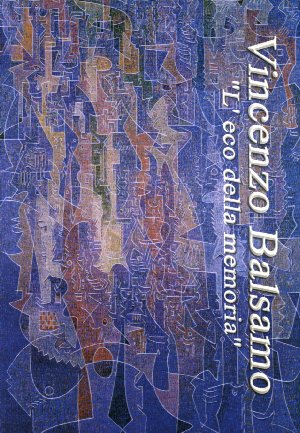|
VINCENZO BALSAMO, A HAPPY RETURN
In the 1970 Vincenzo Balsamo exposes to Turin, landscapes and dead natures characterized
from a intense use of the color stretch out on forms that as they are been translating
in abstraction: the beautiful Campagna di Fiuggi proposes a hill ploughed from lines of color from
the alternate course, "play distillate and dramatic of the light and of the shade" like the critic of
the exhibition organized by Viotti gallery. (1)
Vincenzo Balsamo begins to paint in the 1954 for therefore operate in a small atelier of Via
Margutta to Rome, for which he comes to contact with the masters of the Roman School; any
year later we see the artist hocked in the field of the scenography for the preparation of the
Cleopatra work. A presence still to Zurigo, then the turn in the field of the art, determined in good
person part, from his stays in France where comes to contact with CÚsar and Hartung, authors
that point out with the own works the way of the image resolution and the fragmentation of the
figure.
From that moment - with rare exceptions like happens in the 1999 when he sets in a work,
intentionally Without title, an archaic female profile - the interests of Vincenzo Balsamo,
the his poetic, they are orientated toward works in which the visitor can "read what more attracts to him".
But the theme of the landscape lodges in the mind of the painter still, for which between the
works currently exposed to Turin they appear Amalfi, Dal Gianicolo until to the interesting
painted Presenza marina descent chromatically on a backdrop where the blue color become
cobalt blue, where the "presences" they engage variegated forms in manner of feeling.
Amalfi wave for an ideal urban web unlimited in the sea that comes "sounding, sectioned, faced
in the endless facets through a swarming of signs" like Giovanni Granzotto annotated in the
grandiose, careful monograph again of printing cool.
The ART-MUSIC relationship has fascinated the artists of the 20th century; Arnold Schonberg is
having appreciated from Kandinskij, in the 1928 Oskar Schlemmer project the own distempers
in tuning with the music of LesNoces ( "Fable colors for Stravinski," G. Pestelli), Max
Neuhaus in Rivoli transforms the art in sonorous installation.
An interesting series of Balsamo's paintings draws sprouts from the conflicting sonorous
weavings of big artists what Wagner, from the musical strokes of a Ouverture, whose sound
explodes to the center of the cloth for shatter to the borders; also the sea has an own music, for
which bears the painting, Ascoltando il mare animate from minuscules stains of color that
shatter in image. It is the picassiana voice that wants to transform a stain of yellow color in sun,
and not vice versa.
The chromatic range individualized from Vincenzo Balsamo often extends to fall through in the
blue color: the musical texts of Wagner suggest a chromatic inversion instead, so the rose-
yellow, the oranges outlined of white, sky blue, they become animated in a fate of
neodivisionism that draws the own roots from the Seventy years when the author - abandoned
the combustion oil of tragedian matter made - he approach to Action painting composed of
endless networks to symbolize the latent moral crisis of the humanity. Often the art gives life to
the shades: here then Un ricordo, work not forgetful of the landscape, it am also translated in
feeling, in which the forms exaggerate emergents toward the light or InterioritÓ (2000) highest in
the ring of the brillant green.
In year 2000 Vincenzo Balsamo returns to assign a title for each his work: positive operation that
mostly approaches the public to the author that he entrust to the art of the paint the own Liberi
pensieri, the desire of Guardare oltre il confine in the search of internal spaces, of emotions
that are make concrete in a follow of thin lines, chromatics weavings, circles and ellipsis;
endless lights, and voices that are identified with the mysticism, while quiet becomes the echo of
the memory.
They return to the mind then the words of Frank Elgar:
| |
"The reality becomes an obstacle; the only reality that
count, the only that it have an indisputable character
of authenticity and of effectiveness is the internal reality
that of the intellect, of the imagination, of the
feeling". (2) | |
Gian Giorgio Massara
1) Cfr. C. Giacomazzi, Vincenzo Balsamo, May 1970, Camedda Ed.
2) Cfr, The modern paint, V, The abstract paint, Hazan, Paris 1965, p.8.
| |

